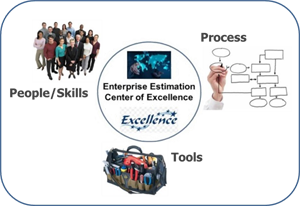When an organization wants to proactively manage their software activities from inception through development and sustainment, an enterprise software estimation or acquisition Center of Excellence (COE) is a great solution. A significant portion of our professional services business at QSM is helping companies design and stand up enterprise COE operations.
There are three main components to a successful COE implementation. They are:
 People – Finding people with the right characteristics and developing their skills;
People – Finding people with the right characteristics and developing their skills;- Business Processes – developing the right business processes to support decision making; and
- Tools – Acquiring and configuring analytical tools to support the business processes.
Our clients often ask us to identify the best characteristics and skills for a person that they plan to staff into a COE. We went back and looked at our most successful implementations, and here is what we found.
Ideal Enterprise COE Skill Set:
- Basic Development Skills. SLIM models system development projects. A basic understanding of the technical work being performed enables the estimator to configure SLIM to different project and group development environments. Incorporating the appropriate terminology, development methods, and workflow aids both in the SLIM model calibration and the gathering of historical data.
- Analytical Skills. SLIM is an analytical decision support tool. As a user of the SLIM tool, one has to be comfortable working with data and numbers. A basic understanding of business statistics is good knowledge to have. One should have the ability to analyze data, identify trends, and determine how to effectively use those trends in future analysis.
- Communication Skills. The use of SLIM involves dealing with a diverse group of people within the organization. Software size and productivity inputs to the tool generally come from technical staff. Project constraints come from stakeholder or commercial managers. People interested in consuming the results are project managers, stakeholders, customers, financial managers, technical managers, and project staff. So it is quite important for the SLIM analysts to have good communication skills. They need to be able to extract the information that they need in order to do the analysis in a non-threatening way, and to allow them to package the resulting assessment into a decision document or presentation appropriate to the audience.
- Presentation Skills: The outputs of SLIM are used to help make decisions, so the packaging of the relevant information into a digestible briefing is a large part of the SLIM analyst’s task. Make sure to find someone who has good packaging and presentation skills.
- Mediation & Conflict Resolution Skills: Project estimation might better be called project negotiation. There are always trade-offs among the capability and the customer’s desires, the time and money that is available, and the required reliability at deployment. Negotiations often result in heated debates among developers, customers, managers, and sales personnel. To make progress toward a solution, a SLIM analyst needs to be able to defuse the situation and then provide objective and practical alternatives that allow the interested parties to better understand the realities and move toward a compromised solution that is the best for all. Thus, conflict resolution and mediation skills are an important consideration.
- Planning & Execution Skills: If you are considering a large enterprise deployment, then planning and execution becomes an important skill set. Having a logical plan for data collection, template building, training, and deployment are all critical success factors.
- Mentoring Skills: If you are staffing up an estimation function, you want people who can share their knowledge and experience with the newer members of the team. This allows you to quickly jump start the group and leverage corporate experience, process, and intellectual property.
- Functional Sizing Skills: One of the biggest challenges in getting started is finding a functional sizing method to which engineers will be able to relate. It gets at the fundamental question of identifying what has to be built. There are various methods that can work successfully, among which are the more common function points, standard components, requirements, use cases, stories, and story points. If your candidates have experience in any of these areas, it can be a significant benefit.
The importance of selecting the right people for implementing an estimation COE cannot be understated. Combined with the right tools and business processes, you will have a capability that will support a variety of levels within the enterprise.
- C-level: Performance benchmarks and dashboards, strategic program risk assessment, demand management, and portfolio performance optimization;
- Project managers: Realistic schedules and budgets, resource optimization, negotiation and risk assessment;
- Business stakeholders: Transparency and a partner relationship with a development organization; and
- Acquisition stakeholders: Visibility into supplier capabilities and performance, best price/value.
Ultimately, an estimation COE solution provides the foundation and resources to achieve such organizational benefits.
Interested organizations can read about our many proven tool and consulting solutions, including the Center of Excellence, that will put the intelligence behind your successful software projects.
